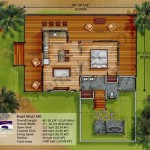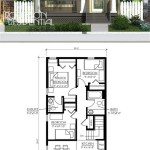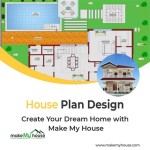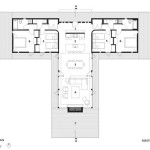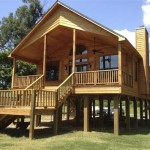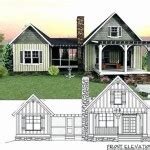Barrier-free house plans, also known as accessible design, refer to the creation of residential structures that are designed to be accessible and functional for individuals with disabilities, mobility impairments, or age-related limitations. These plans prioritize the elimination of physical barriers within the home, allowing individuals to navigate and use the space safely and independently.
For example, a typical barrier-free house plan may include features such as wide doorways and hallways, ramps or elevators for accessing different levels, roll-in showers or walk-in bathtubs, and accessible kitchen appliances. By incorporating these design elements, individuals with disabilities or limited mobility can live comfortably and with dignity in their own homes.
In the following sections, we will delve into the various aspects and benefits of barrier-free house plans, exploring how they can enhance the quality of life for individuals with disabilities and promote a more inclusive and accessible society.
Barrier-free house plans offer numerous advantages for individuals with disabilities and the elderly, promoting independence, safety, and accessibility within their homes.
- Wide doorways
- Roll-in showers
- Ramps or elevators
- Accessible kitchens
- No-step entries
- Grab bars
- Universal design
- Increased independence
- Improved safety
These features work together to create a living environment that is comfortable, functional, and dignified for individuals with disabilities or mobility impairments.
Wide doorways
Wide doorways are an essential feature of barrier-free house plans, providing easy and safe access for individuals using wheelchairs, walkers, or other mobility aids. They also benefit individuals who have difficulty navigating narrow spaces or carrying items through doorways.
- Clear width of 36 inches: This allows for a wheelchair to pass through comfortably, even if the user is turning or maneuvering.
- No thresholds or raised edges: Thresholds can create a tripping hazard for individuals with mobility impairments. A level surface without any raised edges ensures smooth and safe passage.
- Lever-style handles: Lever-style handles are easier to operate for individuals with limited hand dexterity or strength, compared to traditional doorknobs.
- Automatic door openers: For individuals with severe mobility impairments, automatic door openers can provide independent access to rooms and the home.
Wide doorways not only enhance accessibility but also contribute to a more spacious and inviting living environment for all occupants.
Roll-in showers
Roll-in showers are a crucial component of barrier-free house plans, providing safe and accessible bathing facilities for individuals using wheelchairs or other mobility aids. Unlike traditional showers with a raised curb, roll-in showers feature a curbless entry, allowing wheelchair users to roll directly into the shower area.
The design of roll-in showers prioritizes safety and comfort. The shower floor is typically sloped towards a drain, eliminating the risk of water pooling and reducing the likelihood of slips and falls. Grab bars are strategically placed within the shower area, providing support and stability for individuals with limited mobility.
Roll-in showers often incorporate additional features to enhance accessibility and convenience. These may include:
- Fold-down or removable shower seats: These provide a comfortable and safe place to sit while showering.
- Handheld showerheads: These allow individuals to shower while seated or standing, depending on their needs.
- Built-in soap dishes and shampoo dispensers: These eliminate the need for bending or reaching, ensuring accessibility for individuals with limited mobility.
Roll-in showers not only improve accessibility but also contribute to a more dignified and independent bathing experience for individuals with disabilities. By eliminating barriers and providing a safe and comfortable environment, roll-in showers empower individuals to maintain their personal hygiene and well-being with greater ease and confidence.
In addition to the aforementioned features, roll-in showers may also incorporate other design elements to enhance accessibility and comfort, such as:
- Non-slip flooring: This reduces the risk of slips and falls, especially for individuals with limited mobility.
- Temperature control valves: These allow individuals to adjust the water temperature easily and safely, minimizing the risk of burns or scalding.
- Accessible lighting: Proper lighting ensures that the shower area is well-illuminated, enhancing visibility and safety for individuals with low vision.
Ramps or elevators
Ramps and elevators are essential components of barrier-free house plans, providing safe and accessible means of navigating different levels within a home for individuals using wheelchairs, scooters, or other mobility aids. Ramps offer a gradual incline that allows individuals to move between levels without the need for stairs, while elevators provide a vertical transportation solution.
Ramps should be designed with a slope that is not too steep, typically around 1:12, meaning a 1-foot rise for every 12 feet of length. The surface of the ramp should be non-slip and have a handrail on both sides for support and stability. Ramps may also incorporate landings or resting areas along the way for individuals who need to pause or catch their breath.
Elevators, on the other hand, provide a more convenient and effortless way to travel between levels, especially for individuals with severe mobility impairments or who use wheelchairs. Elevators should be large enough to accommodate a wheelchair and have automatic doors and controls that are easy to operate.
Both ramps and elevators play a crucial role in creating a barrier-free home environment. By eliminating the need for stairs or other inaccessible features, ramps and elevators empower individuals with disabilities to move freely and independently throughout their homes, enhancing their quality of life and overall well-being.
When designing ramps or selecting elevators for barrier-free house plans, it is important to consider the specific needs and preferences of the individuals who will be using them. Factors such as the slope of the ramp, the size of the elevator, and the location of the controls should be carefully evaluated to ensure optimal accessibility and comfort.
Accessible kitchens
Accessible kitchens are an integral part of barrier-free house plans, ensuring that individuals with disabilities or mobility impairments can safely and independently prepare and cook meals, as well as access and use kitchen appliances and storage areas. The design of accessible kitchens prioritizes functionality, ergonomics, and ease of use, creating a space where individuals can move around comfortably and perform kitchen tasks with dignity and independence.
One of the key features of accessible kitchens is the provision of ample space for wheelchair users to maneuver. This includes wide aisles and turning radiuses that allow individuals to move freely around the kitchen, reach appliances, and access storage areas without difficulty. Countertops and sinks should be at a height that is comfortable for individuals using wheelchairs, typically around 30-34 inches from the floor. Additionally, adjustable-height countertops or work surfaces can be incorporated to accommodate different user needs and preferences.
Accessible kitchens also incorporate specialized appliances and fixtures to enhance usability and safety. For example, cooktops with front-mounted controls allow individuals using wheelchairs to operate them easily and safely without reaching over hot surfaces. Wall-mounted ovens and microwaves eliminate the need for bending or stooping, making them more accessible for individuals with limited mobility. Pull-out shelves and drawers provide easy access to stored items, while hands-free faucets and voice-activated appliances offer convenient and accessible operation.
Other important considerations for accessible kitchens include:
- Non-slip flooring: This reduces the risk of slips and falls, especially for individuals with mobility impairments.
- Adequate lighting: Proper lighting ensures that all areas of the kitchen are well-illuminated, enhancing visibility and safety for individuals with low vision.
- Universal design principles: Universal design principles guide the design of accessible kitchens, ensuring that they are usable and accessible to individuals with a wide range of abilities and disabilities.
Accessible kitchens empower individuals with disabilities to live independently and enjoy the same level of functionality and convenience in the kitchen as anyone else. By incorporating these design elements and features, barrier-free house plans create a kitchen environment that is both safe and accessible, promoting dignity, independence, and quality of life.
No-step entries
No-step entries are an essential feature of barrier-free house plans, providing level access to the home for individuals using wheelchairs, scooters, or other mobility aids. They eliminate the need for steps or stairs, which can pose significant barriers for individuals with mobility impairments.
- Flush thresholds: Flush thresholds eliminate the raised edge between the interior and exterior of the home, creating a smooth and seamless transition. This allows individuals using wheelchairs or other mobility aids to enter and exit the home without having to negotiate a step or threshold.
- Ramps: Ramps provide a gradual incline that allows individuals to enter the home without having to climb steps. Ramps should be designed with a slope that is not too steep, typically around 1:12, and should have a non-slip surface and handrails for safety.
- Zero-threshold doors: Zero-threshold doors are designed without a raised threshold, allowing individuals using wheelchairs or other mobility aids to enter and exit the home without having to lift their wheels or scooters over a barrier.
- Automatic door openers: Automatic door openers can be installed on exterior doors to provide hands-free access for individuals with limited mobility or who use wheelchairs.
No-step entries not only enhance accessibility but also contribute to a more seamless and welcoming living environment for all occupants. By eliminating barriers and providing level access to the home, no-step entries promote independence, safety, and dignity for individuals with disabilities.
Grab bars
Grab bars are an essential safety feature in barrier-free house plans, providing support and stability for individuals with mobility impairments, balance issues, or who are at risk of falling. These bars are typically installed in bathrooms, showers, and other areas where there is a risk of slipping or falling, such as near toilets, bathtubs, and showers.
Grab bars should be securely fastened to the wall or other supporting structure and should be able to withstand a force of at least 250 pounds. They should be placed at a height that is comfortable and easy to reach for individuals using them, typically between 33 and 36 inches from the floor. Grab bars come in a variety of shapes and sizes, including straight, angled, and U-shaped bars, to accommodate different needs and preferences.
In addition to their safety benefits, grab bars can also enhance independence and dignity for individuals with disabilities. By providing support and stability, grab bars allow individuals to perform daily tasks such as bathing, toileting, and getting in and out of bed with greater ease and confidence. This can significantly improve their quality of life and well-being.
When designing and installing grab bars in barrier-free house plans, it is important to consider the specific needs and preferences of the individuals who will be using them. Factors such as the height, placement, and type of grab bar should be carefully evaluated to ensure optimal safety, comfort, and accessibility.
Grab bars are a crucial component of barrier-free house plans, providing essential support and stability for individuals with mobility impairments or who are at risk of falling. By incorporating grab bars into the design of accessible bathrooms, showers, and other areas, barrier-free house plans promote safety, independence, and dignity for individuals with disabilities.
Universal design
Universal design is a design approach that focuses on creating environments and products that are accessible and usable by people with a wide range of abilities and disabilities. It aims to eliminate barriers and create inclusive spaces that can be used by everyone, regardless of their age, size, ability, or disability.
In the context of barrier-free house plans, universal design principles guide the design of the home to ensure that it is accessible and usable by individuals with disabilities, as well as by individuals without disabilities. This includes considering the needs of individuals with mobility impairments, sensory impairments, cognitive impairments, and other disabilities.
Universal design in barrier-free house plans involves incorporating features such as wide doorways and hallways, no-step entries, accessible kitchens and bathrooms, and grab bars throughout the home. It also involves considering the placement of furniture and appliances, the use of contrasting colors and textures, and the provision of assistive technologies to enhance accessibility and usability for individuals with disabilities.
By adopting universal design principles, barrier-free house plans create living environments that are not only accessible but also comfortable, safe, and welcoming for everyone. This approach promotes independence, dignity, and quality of life for individuals with disabilities, while also benefiting individuals without disabilities by creating a more inclusive and accessible built environment.
Incorporating universal design principles into barrier-free house plans is essential for creating truly accessible and inclusive living environments. By considering the needs of individuals with a wide range of abilities and disabilities, barrier-free house plans can empower individuals to live independently and with dignity, while also promoting a more equitable and inclusive society for all.
Increased independence
Barrier-free house plans are designed to increase independence for individuals with disabilities by eliminating physical barriers and creating a more accessible living environment. This can have a profound impact on their quality of life, empowering them to live with greater autonomy and dignity.
- Easier navigation and movement: Wide doorways, ramps, and no-step entries allow individuals using wheelchairs or other mobility aids to move around the home safely and independently, without the need for assistance.
- Accessible bathrooms and kitchens: Barrier-free bathrooms and kitchens are designed with features such as roll-in showers, accessible sinks, and pull-out shelves, enabling individuals with disabilities to perform daily tasks such as bathing, cooking, and cleaning with greater ease and independence.
- Reduced risk of falls and injuries: Grab bars, non-slip flooring, and adequate lighting help to reduce the risk of falls and injuries, providing individuals with disabilities with greater peace of mind and confidence in their ability to move around the home safely.
- Improved self-esteem and well-being: Increased independence and autonomy can significantly boost self-esteem and well-being for individuals with disabilities. They are able to participate more fully in daily activities, engage in hobbies and interests, and live a more fulfilling life.
Overall, barrier-free house plans empower individuals with disabilities to live independently and with dignity, allowing them to fully participate in all aspects of life and enjoy a greater sense of freedom and well-being.
Improved safety
Barrier-free house plans prioritize safety for individuals with disabilities, creating a living environment that minimizes risks and promotes well-being. By eliminating physical barriers and incorporating safety features, barrier-free homes empower individuals to live independently and securely.
- Reduced risk of falls: Wide doorways, no-step entries, and grab bars throughout the home help to reduce the risk of falls, which are a common safety concern for individuals with mobility impairments. Non-slip flooring and adequate lighting further enhance safety by preventing slips and ensuring clear visibility.
- Easier evacuation in emergencies: Barrier-free house plans often incorporate features that facilitate evacuation in case of emergencies, such as ramps or elevators for easy access to different levels of the home. Wide doorways and hallways allow for quick and safe passage, even with mobility aids.
- Improved fire safety: Smoke detectors and fire alarm systems are essential safety features in any home, but they are particularly important in barrier-free homes where individuals may have limited mobility. Visual and audible alerts ensure that individuals are notified of a fire and can evacuate safely.
- Enhanced accessibility for medical assistance: Barrier-free homes are designed to allow medical professionals and emergency responders to access the home and provide assistance easily. Wide doorways and hallways enable medical equipment and stretchers to be brought in without difficulty, ensuring timely and effective medical care.
Overall, barrier-free house plans create a safer and more secure living environment for individuals with disabilities. By addressing potential hazards and incorporating safety features, these homes promote peace of mind and well-being for occupants.










Related Posts

